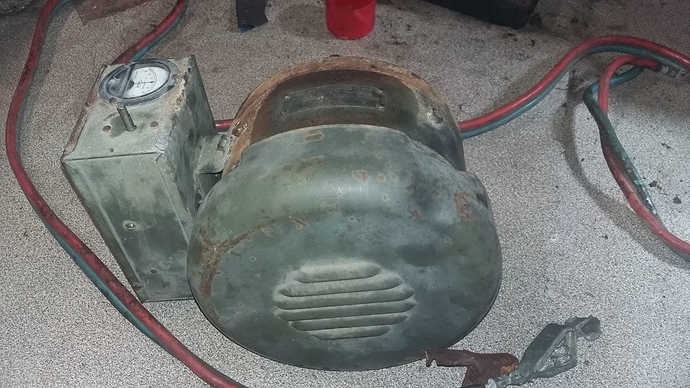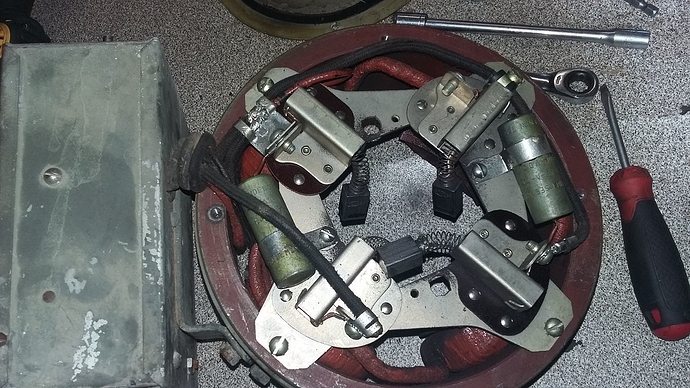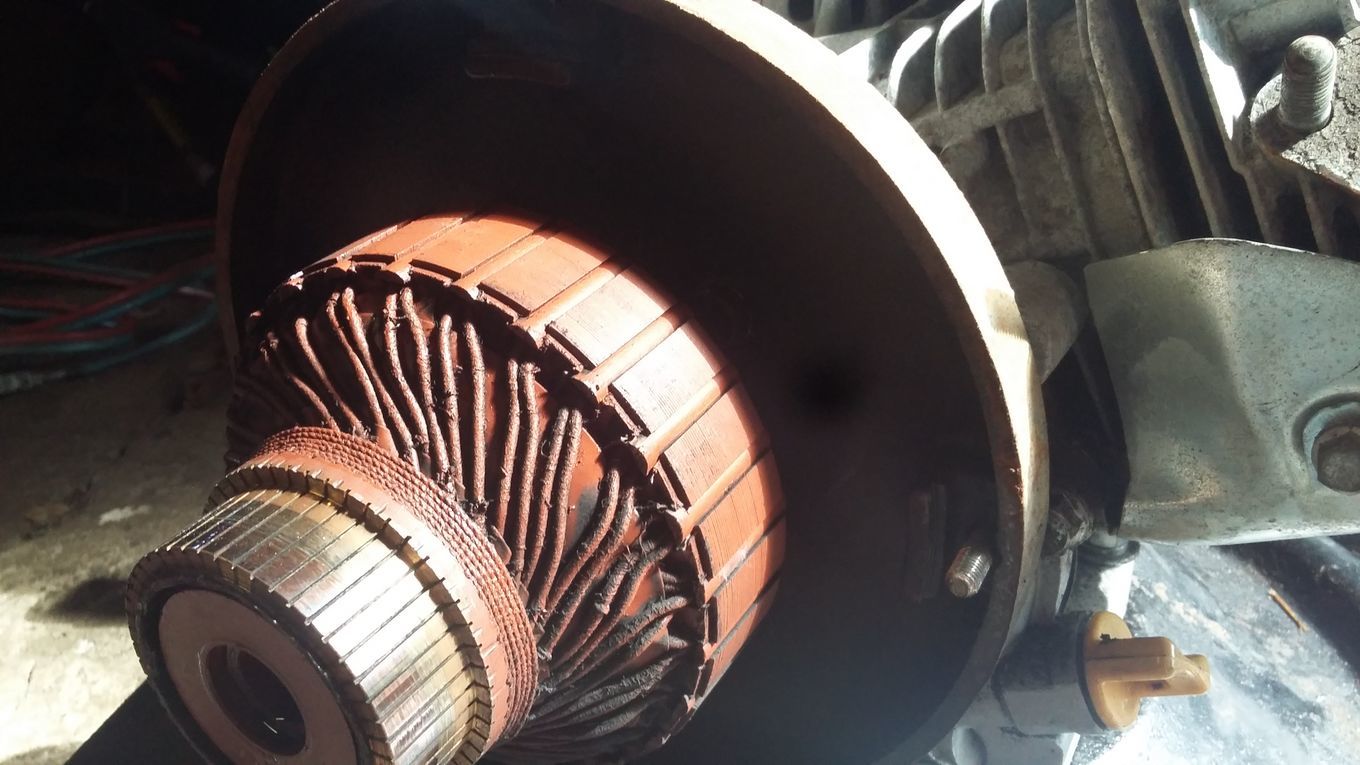The trick to unchared wood free charcoal is to use thiner peaces of wood. I used to make charcoal out of thinly split wood (less thain 5cm diameter) in a 200l oil barrel TLUD. No unchared wood, burn time about an hour, produced about 8 kg of charcoal per barrel. But the prepareing of the wood was a pain. Took me about half an hour to prepare and load the wood. Now l just load it with thicker firewood and light the middle of the barrel. Takes almost no time to prepare and but produces a lot of unchared wood. It is still simpler and faster thain spending half an hour with an axe…
i always keep getting back to this basics…
Make the drum rotating… saves time and gives quality output, over and over again…
Ofcourse, with some more walls and a suitable liquid collector 
Burn Report
As mentioned above, I put 2 55 gallon barrels full of slab wood in the BBQ pit a couple of nights ago, and lit it off.
Based on the way the burn went, I was optimistic that I would have some good charcoal.
That was mostly true.
The barrel in the back of the pit was better than half full of high quality charcoal. No brands, and no torified wood.
The front barrel, however, contained about 7-10 gallons of brands and torified wood. The rest was good charcoal.
I am guessing that the difference is that the back of the pit is all masonry, whereas the front of the pit has the end loosely blocked with a piece of tin. So, the back of the pit was probably holding the heat better.
Anyway, pretty pleased with the results.
Ended up with a 55 gallon barrel full of charcoal ready to be crushed.
Plus a little. Which will be going to Argos.
The Shot Heard Around Argos
We rolled into Argos about 10:00 PM Friday night - just in time to find Gary Gilmore and a few others making charcoal at the pavilion.
Although we took our charcoal generator with us, we were planning on keeping a low profile since we were the “new guys.” But when we mentioned we had it with us, Gary suggested we unload it front and center where the charcoal talk was going to happen the next day. We did. And you can probably imagine the rest of the story.
The next morning, we decided to give it a test run. Gary looked it over and noticed our lid seal looked a little leaky. Everybody pitched in and tried to help us get it patched up. But I guess that didn’t exactly work out.
We fired it up, and got a good flare. OK. Now, time to start the notoriously hard to start generator with everybody looking.
The first thing to go kaput was our ratcheting socket used to start the generator. It failed on the very first try. So, we tossed the ratchet and went back to the “direct drive” method with the drill.
The next thing to go kaput was the two “freshly charged” harbor freight drill batteries that were not charged at all, so far as I could tell.
But they didn’t entirely fail before we managed to generate a really nice backfire which, combined with our air leak, taught us the meaning of the words “puff-back.”
Apparently, that is a nice way of saying “explosion.”
It sounded like a 12 gauge going off. If it had been a potato cannon, it would have been great. But that wasn’t supposed to happen.
Anyway, as it turns out, my “toilet plungers” on the blower turned out to be good pressure relief valves.
The downstream plunger cleanly ejected the PVC pipe from its clutches. No harm done, since it was tethered to the air intake with a piece of sump pump hose.
The upstream plunger, on the other hand, took the brunt of the force. It blew apart, leaving a nice ring of rubber still clinging tenaciously to the blower.
As several guys were kind enough to mention, the “puff-back” was apparently heard on the other side of the fairgrounds, where the wood-gas guys were set up.
After I got done “ducking and covering” I assessed the damage.
Not pretty, but it didn’t look too bad.
Fortunately, there is a hardware store right across the street from the fairgrounds (saw a few other wood-gasser guys in there too, but I won’t call any names).
I was hoping to come up with a classier fitting than a toilet plunger, but no luck. Had to get another toilet plunger.
Thanks to Dan Moore’s generosity in providing a few parts (and a drill and some more batteries), Gary’s advice on repairing the damage, and Wayne’s duct tape, we were ready to go again by 1:00.
The charcoal guys gave their excellent presentation and, when they were done, we were ready to try it again.
It looked like we were making good gas, but we just rolled the engine over and over and could never quite get it to start.
We were feeling depressed and defeated.
Then Gary reached down, and started turning the crankshaft over by hand. He had two words: “No compression.”
Sure enough, you could spin the thing with your fingertips. There was not even a hint of a compression stroke.
We knew we had valve problems with this thing, and I guess they finally caught up to us at Argos (with everybody looking).
Matt immediately suspected a problem with the intake valve, and generously offered to pull the valve cover off (we had no tools). But we declined, figuring a valve job was a little much to undertake on the spot.
Fortunately Mike Larosa was standing around and, just to prove we were making good gas, he lit several napkins, paper plates, and other discarded items off the flare can.
Gary generously suggested that we should pipe our gas into his generator just to get a run. We did that. And it started up beautifully. But then the engine would accelerate, and suddenly die.
We kept at it for a little while, but finally admitted defeat.
We were really scratching our heads over that one.
As we learned later, Gary’s throttle was stuck wide open, and the rev limiter (or something) was shutting his generator down.
We really should have felt like a couple of shmucks after all that. But everybody was so nice and so helpful that it turned out to be a great (if humbling) experience anyway.
Kyle, I was very happy to see you and Hoss show up with your stuff at Argos. I always enjoyed reading your posts and seeing your set up in person was fun. It is always amazing to see how many guys quickly stand around trying to help out when things are not going as planned.
The Rest of the Story
So, anyway, as soon as we got home, we pulled the valve cover off the generator engine.
Nothing obvious.
Next, we snaked our high tech $89 optical video scope into the spark plug hole and found that the intake valve was totally burned (that harbor freight stuff is great, when it works).
Mystery solved.
We will have to patch that up.
But, speaking of Harbor Freight, we happened to pass right by one in Terre Haute on the drive back.
A 13 HP electric start Predator Engine followed us home.
What we learned at Argos
We learned more than I could write here.
But I am trying to get my thoughts down about what we learned that would help us with this specific project (charcoal gas generator for solar backup / recharging).
The main thing that we learned is that these “no nozzle” designs look very promising. Both Gary and Don appear to be having pretty good luck with theirs so far (aka no melt downs).
While I was standing around, I kept noticing a strange looking articulating tractor running around the fairgrounds. I also noticed that it sat around idling quite a bit, and didn’t seem to be getting hot, but just kept on running.
I think this belongs to Jeff Davis. Anyway, I caught up to him late Saturday, and got a good look at his machine. It is so innovative in so many different ways that it is hard to know where to start.
Given the novel steering arrangement and other “wow” features, it was easy to overlook the charcoal gasifier.
But the gasifier, in itself, was pretty innovative as well.
I don’t know if Jeff has described this gasifier in detail in any of the threads, but if he has, I haven’t found it yet.
Anyway, it was a “no nozzle” hearth style design as well. And perhaps the simplest, most robust, and easiest to maintain that I have seen. It definitely deserves a closer look.
Hi Kyle, thanks for the kind words. I didn’t catch on that you where the one up front. Dang because I wanted to say hi a lot more. I have a hard time connecting forum people to the people I see in person… 
I’ll post about the gasifier maybe on one of the topics I already started or start a new one. Maybe I shouldn’t start too many new topics…
Project Status
So far, I have mainly been trying to prove to myself that I can build a charcoal fired generator that I can use to reliably supplement my solar panels for battery charging when the sun isn’t shining.
Based on what I have seen and experienced so far, it looks doable.
On the gasifier side, I am leaning towards going with a “no nozzle” design.
Now, I am starting to think about what to do on the charging side.
I have been using my old worn out generator for testing purposes. But it finally bit the dust at Argos. We can probably repair it, but I have been planning all along to go with a better generator once I got past the proof of concept phase with the gasifier.
When I was at harbor freight yesterday, I had to make a decision. Either I would buy a new predator generator, or I would buy a predator engine and make my own generator.
I decided to go the route of buying the engine separately
While this complicates my design, I think it will give me a better experimental platform, and also a more robust system in the long term. For example, if the motor, or the gen head breaks, I can just switch out that component without having to replace the whole unit in a hurry.
Now, I am in the very early stages of deciding what to do about a gen head.
The easiest thing to do would be to purchase an off-the-shelf gen head, like this one from harbor freight.
http://www.harborfreight.com/10000-watts-max-7200-watts-rated-belt-driven-generator-head-45416.html
I could then add an off the shelf 3 stage battery charger and be done.
However, I am giving some consideration to taking a more “hands on” approach.
One thing I could do is use a high capacity 24V alternator, and build my own charge controller - probably using an Arduino. I think this would probably be a more efficient setup, since I could decrease the engine RPM during the absorption stage to reduce fuel consumption.
Except as a learning exercise, I doubt that it would be worth the effort to do all of this myself.
On the other hand, it might be nice if we had an “open source” arduino based charge controller since charge controllers are still somewhat expensive.
What do you guys think?
Your first stop should be the micro cogeneration site. www.microcogen.info the site is populated with lots of dc chargers and marine types lots of controller info. The engines are mostly diesel but the Gen head info is valid. It’s quite a rabbit hole!!! Hours of absorbtion.
Best regards, David Baillie
Store bought generator engines have taper shafts. Your engine has a more useful straight shaft.
I have that generator but never used it. One fellow had the windings extra repainted.
Maybe DC alternated belted on one side feeding a wind charger. On the other side belt an ac generator. That way you could tighten up the side you want to use.
Just hot air…
Building a 3 stage charger would not be that hard.
But I would make it simpler and just build a 2 stage unit and leave the 3rd stage to a solar source.
The fuel you burn to do the third stage is the problem.
Run for hours to top up…
Hi Kyle , while you were all away enjoying yourselves this weekend i was left at home to do some shopping and i came across on ebay a $60 unit complete with engine after costing the shipping of the complete unit with engine i paid the guy $60 to strip the gen head off the engine and $40 to post it to me , didnt really need it but its so old guess around 1940,s i couldnt let it go , i think this would type would be a nice little set up for a small engine .
Looks in great shape for the age .
Dave
Kyle,
This is what I bought when I had a job. It’s an inverter generator head which is supposed to be better for electronic devices. Just remember to make sure you double the hp requirements on your engine. I haven’t had time yet to hook it up effectively but will this summer.
Dave:
What you have there looks like an old military APU for something.
I have one of those made In Canada with the little Johnson chore horse engine.
I am not sure if they made these in these in USA for the military but I am fairly sure they made some like this video. ( you may have something like it with different engine and generator head )
These units not only generate but they can motorize and electric start with the same windings.
Some like mine had a 300 watt 110ac plug and could charge 6 volts DC
this is not mine but its almost identical.
After thinking this through, I am leaning towards going with a conventional 120/240 gen head and an off the shelf 3 stage charger.
While I think the 24V alternator and homeade charge controller would be more technically interesting, and more efficient, I have decided that the extra redundancy of the conventional setup is probably the wiser choice.
This generator is going to be located in my “power house” where all the solar charge controllers and batteries are located. I distribute power from there after it is already inverted to 120/240.
So, with the conventional gen head, I will have the option of distributing power directly from the generator to my grid in the event of a failure in the solar power system or even the battery bank and/or inverter.
Jeff - You said that you “have that generator but never used it.”
Are you talking about the “Chicago Electric” Generator Head that I posted the link to?
If you never used it, are you interested in selling it?
Hi Dave
That is a neat looking unit.
It just so happens that I had my Warn 9000 lb winch taken apart this afternoon.
And the internals of it look almost exactly like the inside of that thing.
Bet it would run as a motor as well.
Kyle, that’s it or an older version of it. It did cross my mind to sell it to ya. No sure. If so at Argos would have been just the ticket. It feels like it’s made of lead so forget shipping. Not sure what I should do with it.








